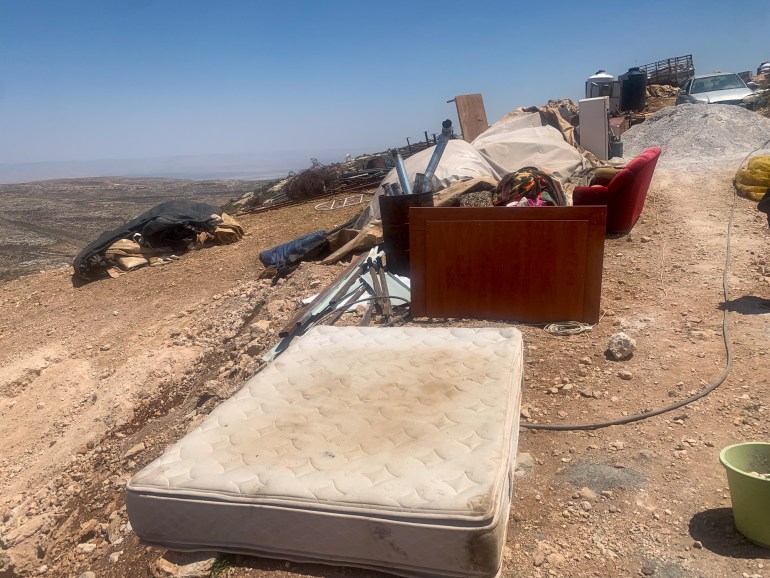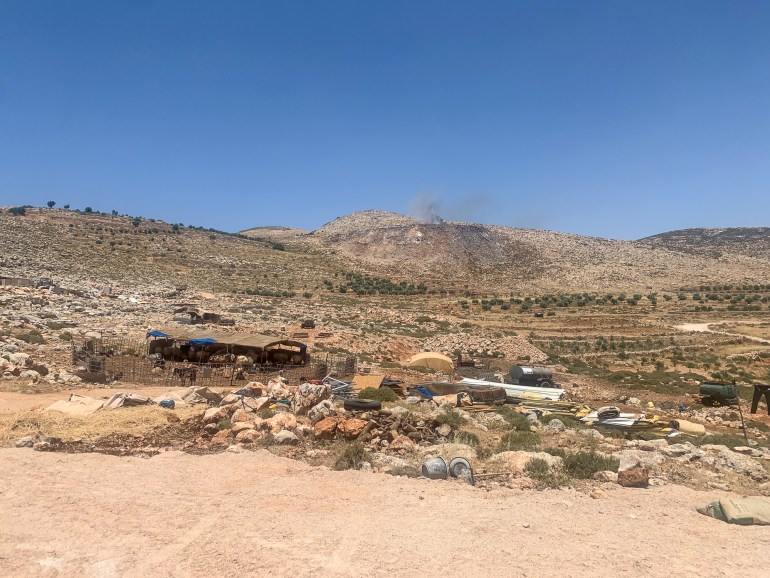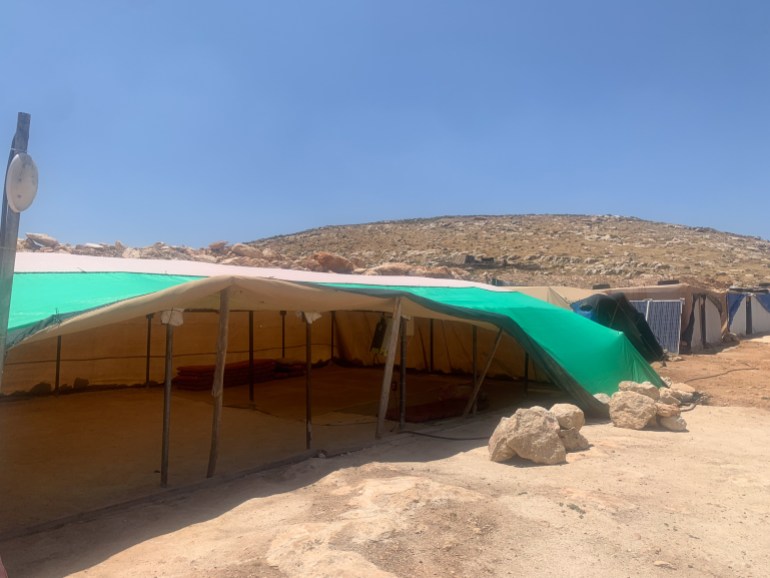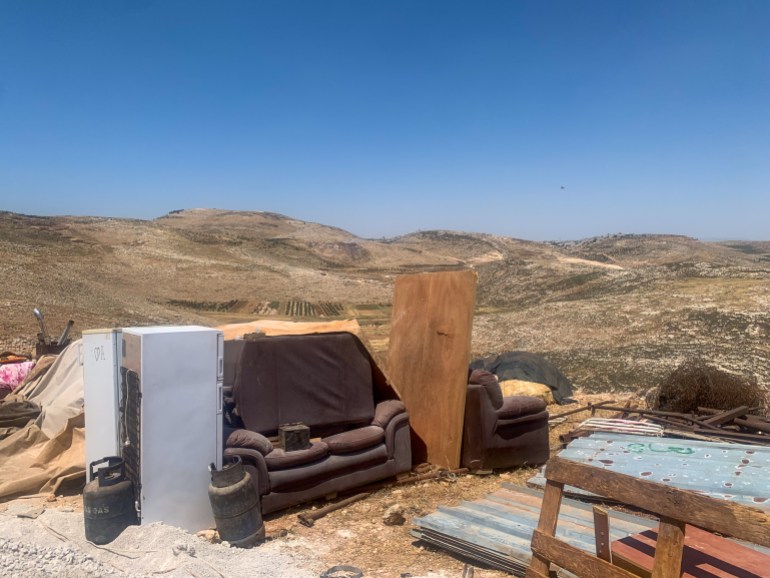“When we sit together, we only remember the nice moments we left behind in Ein Samiya, how we played on the land when we were small kids,” said Ibrahim Kaabneh, a young herder and new father. “We don’t want to think about the current situation … or the future.”
Kaabneh was sitting on an upside-down bucket near what his mother, wife and baby struggled to call home. The flimsy black tent was propped up by wooden sticks and held down with rocks on the edges to keep it from blowing away. On the hard dirt floor inside were a stove, stacked pots, a couple of small cabinets, and a crib filled with blankets and mattresses. His wife Fatima and mother Amina sat on cheap mattresses in the tent, trying to comfort their baby girl, Amal.
Without enough space inside, the rest of the family’s items were strewn outside the tent – a couch, a full-size mattress, cabinets, and appliances. “There’s no comparison to what [our home] was like before – comfortable, well-insulated, with electricity and a good floor,” Kaabneh said.

Now, he and the rest of the displaced village have lost that – along with the elementary school, a way to make a living and a sustainable future as Bedouins in their new location.
Many structures in Ein Samiya – including its school – faced government demolition orders as well as attacks from settlers on adults, children and livestock in the village and even at the nearby spring when they went to draw water.
A distraught Abu Najjeh Kaabneh, the mukhtar or chosen leader of the Ein Samiya community, declared: “We are homeless.”
Reaching the ‘killing point’
According to the elder Abu Najjeh, the decision to leave Ein Samiya came after the settler harassment and violence they had been subjected to the past five years ratcheted up to frightening levels. Constantly surveilling the Bedouins’ activities, settlers from nearby illegal outposts were attacking every night, throwing rocks, invading homes and beating villagers.
The “killing point”, said Abu Najjeh, came when Atta Kaabneh’s flock of 75 sheep and goats was stolen in broad daylight while Israeli police watched. Settlers had gone to the police, falsely claiming Atta had stolen their sheep – a pretence to have the police detain Atta and steal all of his sheep.
“Life is no longer possible in this community when there is no way for us to protect our flock,” said Abu Najjeh. Settlers took photos of all their flocks, a signal to community members that none of their flocks was safe.
The night following Atta’s detention and confiscation of his flock, children and young people keeping watch over the village and its flocks were attacked by settlers with stones. They tried to escape – only to run into other settlers positioned to attack them as well. “They felt they were being attacked from all directions,” said Abu Najjeh. “Nowhere was safe.”
Abu Najjeh called nearby village councils and the Palestinian Authority’s Anti-Wall and Colonization Committee, at first seeking safety for the children and women before ultimately deciding the people had to leave altogether.
Facing harassment and attacks from surrounding settlers even while dismantling their homes, the community left as quickly as possible a week and a half ago.
The settlers rejoiced.
Grazing and violence: How to seize land
In the five years since several shepherding outposts – built illegally even under Israeli law, though the Israeli government takes no effective action against them – were constructed around the community, the people of Ein Samiya saw their total flock of 2,500 sheep dwindle to 500, according to Abu Najjeh.
Bedouin communities like Ein Samiya report violent attacks from nearby shepherd outposts up and down Allon Road, which stretches across the northern occupied West Bank. Shepherding outposts – typically comprising only one shepherd and a few volunteers each – have increased dramatically in prominence as a tool to forcibly take land from Bedouin communities since 2018. According to Israeli NGO Kerem Navot (PDF), there are now 61 grazing outposts, 50 of them created since 2018.
According to a late 2021 report (PDF) from Israeli NGO Yesh Din, Israeli government documents reveal plans as early as 1981 to use grazing-permitted areas around settlements to “secur[e] reservoirs of land for future settlement”, advocated by then-Minister of Agriculture Ariel Sharon. Since then, settlements like Metzadot Yehuda, Shvut Rachel, Mitzpe Esthamoa and others have emerged from areas originally designated for grazing only.
Shepherd outposts are bankrolled by several organisations, including Amana – an outgrowth of Gush Emunim, an ultranationalist messianic settler movement, and the main driving force behind these outposts – HaShomer Yosh and the Jewish National Fund. Amana receives millions of shekels each year from local councils in settlements – which are funded by the government – and HaShomer Yosh – an association that sends volunteers to agricultural outposts in the West Bank – receives 65 percent of its budget from the State of Israel.
Taking what Yesh Din calls a “maximum land, minimum settler” approach, these shepherd outposts – in direct, violent confrontation with Bedouin communities yet acting with impunity – have been instrumental in seizing wide swaths of land in Area C of the West Bank, which is under full Israeli security and civil control. Such grazing-oriented outposts now control nearly 7 percent of Area C, according to Kerem Navot figures.

The Yesh Din report cites Ze’ev Hever, Amana’s executive director, boasting that while settlements took about 100sq km (39sq miles) over 50 years, shepherd outposts managed to capture double that area in three years, from 2018 to 2021.
The police’s actions in support of settlers’ violence and theft made the situation impossible.
“The police not only did not investigate [settler attacks], but they were trying to persecute those within the [Ein Samiya] community,” said Wa’il Qut, a lawyer at the Jerusalem Legal Aid Center, which oversaw many of the villagers’ legal cases. “It is a clear example of cooperation between the settlers, the army and the civil administration to force – directly or indirectly – the Bedouin communities [to leave] … this is a clear violation of international law.”
Nearby Bedouin communities and international stakeholders alike fear what this victory will signal for settlers. “Now, in Ein Samiya … it’s set a precedent where settlers have been able to terrify these communities repeatedly and successfully displace them so that they can then illegally settle that land,” said Chris Holt, chief of party at the West Bank Protection Consortium, a partnership of nearly a dozen European states and several NGOs seeking to prevent the forcible transfer of Palestinians.
‘Like having my soul taken out of my body’
Najjeh Kaabneh, Abu Najjeh’s 55-year-old son, now a few kilometres away from Ein Samiya, says: “It would have been better to die there rather than dismantling my house and coming here.”
Dismantling his own family’s home, he says, was “like having my soul taken out of my body”.
Packing up and moving over three days using trucks and tractors, Abu Najjeh arranged for 21 of the village’s 29 families to move to privately owned land a few kilometres away. The land was too small for everyone, so eight families had to find alternatives elsewhere in the West Bank.
What the 21 families found there was less than ideal.
Finding themselves near a polluting quarry and adjacent to cultivated farmland they could not use for grazing, the Bedouin spent the first day on the rocky hilltop, flattening land with heavy machinery to make some space for them. Families spent the first nights sleeping outside. Now, four or five families have to share single tents.
In the days that followed, Najjeh Kaabneh says his wife and small children were finally able to sleep, no longer fearful of settlers storming into their house at night. Others told humanitarian workers they were unable to sleep for the first few days at all, still suffering from the traumatic displacement.
Even here, the villagers had to split up, with Ibrahim’s and six other families moving higher on a rocky hill. There, they joined their relatives, families who came from nearby Ras al-Tin last year in a similar mass displacement resulting from settler violence, demolitions and coercive measures.
Through these remaining families, Ibrahim Kaabneh catches a glimpse of the future that awaits him if he decides to stay here. Some of the Ras al-Tin families managed to install solar panels and build more stable tents in the nearly year they have been there, but their Bedouin way of life is no more. Most of them had to sell their sheep and goats, with men forced to work in Israel or settlements.

Ibrahim worries his fate will be the same – only able to take his flock out grazing 200 metres (650 feet) on the dusty hilltop, Ibrahim says he mostly keeps his sheep and goats in a pen, forced to buy expensive fodder for them. With 10 cubic metres (10,000 litres or 2,642 gallons) of water costing him 400 shekels – and the livestock alone drinking almost a third of that a day – Ibrahim says he has to sell sheep to keep up with expenses. “I expect that within one year, I will have sold all the sheep I own and be forced to work in Israel or Palestinian areas,” he said.
Upon arriving at the new site, Ibrahim’s uncle decided to split up his family, leaving the women and children in the new location, while he took his sheep to an area further north with better grazing conditions. “Our choice is either to sell all the sheep, split the family, or go work outside and not graze the flock any more,” said Ibrahim.
As community ties weaken, nobody is really settling into the new spaces. While the owner of the land – typically used for farming – is letting the families stay there for now, Abu Najjeh is concerned they and their sheep might wear out their welcome soon enough. While they are now in Area B – under Israeli security control and Palestinian civil control, with less risk of demolition threats – their proximity to a hill in Area C is making Ibrahim and others fear that settlers will come and violently displace them again.

Several in the Kaabneh clan called this forcible displacement “another Nakba”. Historically nomadic herders, Bedouins in historical Palestine faced forced sedentarization going back to Ottoman times, and this is the sixth time the Kaabneh clan – today all related through patriarchal relations – have been forcibly displaced since they were first expelled from Be’er Sheva in 1948. In spite of the series of earlier relocations, they managed to spend the last 40 years in Ein Samiya, continuing as herders there until now.
“There is no clear plan for the future,” said Abu Najjeh. “At the moment, I’m not thinking about the future. I’m thinking only about how to protect families and children and living in acceptable shelter.”
With the families deep in depression, humanitarian workers helping the community note an urgent need for psychosocial services in addition to adequate shelter, electricity, sanitation, affordable water and suitable land.
The same children that foreign diplomats saw in school uniforms on a solidarity visit four weeks ago now spend their days wandering around the disjointed encampment – out of school, without a real home and silently dealing with the trauma of settler attacks and forcible displacement. Villagers are exasperated after advocacy from foreign countries and NGOs to protect the community and its donor-funded school made little difference.
As his wife and mother took care of his infant in the ramshackle tent – and with his livelihood as a Bedouin shepherd quickly disappearing – Ibrahim Kaabneh was beside himself: “Many organisations and [foreign] diplomats came promising to protect us and to provide us with support, but nobody supports us actually.
“What they do is nothing,” said Ibrahim. “Nothing.”
